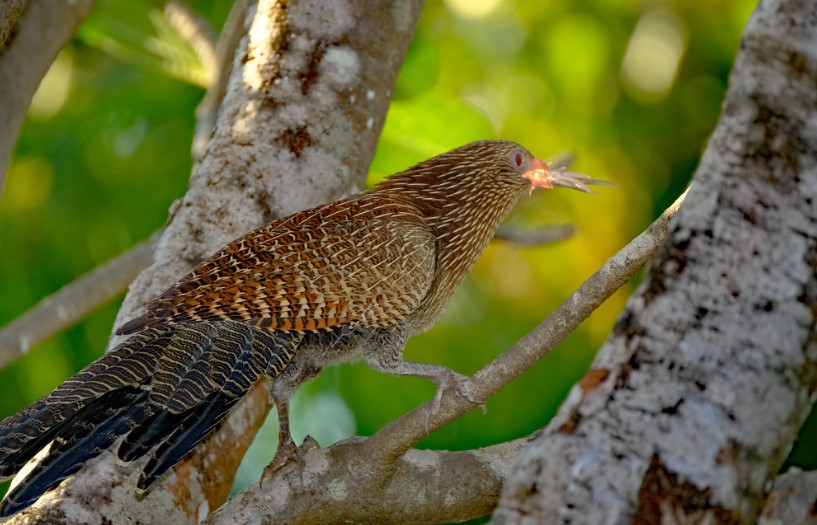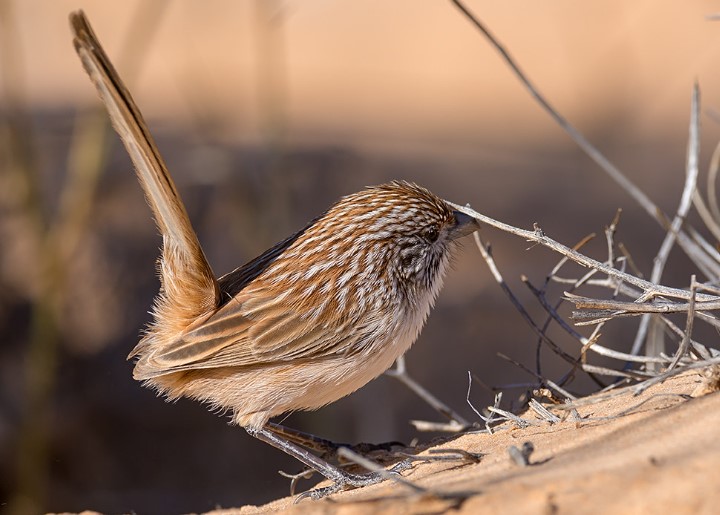Behavior and habitats: The Pheasant Coucal (Centropus phasianinus), a long-tailed bird that lives mostly on the ground, builds its own nest and rears its young. As it tries to restore its limited ability to fly after rain, heavy dew, or hunting in wet undergrowth, it perches on a low bush or posts to spread its long loose plumage. In a series of leaps, the Pheasant Coucal climbs to the top of a tree and glides from one tree to another, fluttering and flopping intermittently on its short rounded wings, a long tail trailing behind.
Both males and females climb trees to collect nesting material. They break off small leafy branches and let them fall to the ground. The branchlets are then dragged through the undergrowth to the nest site. From bush to bush, the birds fly until they reach the leaves in order to return to the source of the branchlets.
A nest site is formed by the birds trapping down the center of a clump of plants and forming a platform. In order to build their nest, they pile leafy green twigs up to a height of about a hundred millimeters. During incubation, the parents add more twigs, and then they pull down the tops of surrounding plants to make a roof for the nest, leaving two side entrances. A sparsely vegetated site may not have enough vegetation for birds to make a dome, so they rely instead on surrounding grasses and herbs to protect themselves.
Both parents incubate their heads and tails protruding through the nest’s opening. Coucals often breed twice each season, building a second nest, laying a second clutch, and incubating it while the first brood is still being fed. Earlier than the second brood is old enough to fly, the first brood’s young are driven from the area.

Diet: Pheasant Coucals consume small reptiles, frogs, house mice, young water rats and bandicoots, large insects, eggs, and young birds, and they take crabs from the mangroves during low tide. They are taken by the bird by running, searching, and threading along in a manner that almost resembles that of a reptile. It hunts to a great extent under cover of a sward of rank grass field, where it establishes territories while breeding and wanders locally afterward.
Other Name: Swamp Pheasant Coucal is another name for it.
Family: Pheasant coucals are species of cuckoos in the Cuculidae family.
Size: Male birds measure about 500-600 mm in length, while females measure 600-700 mm.
Identification: There is no difference between the sexes. Breeding plumage is sooty black from head to tail with shiny black feather shafts. A dull black back is interrupted by faint buff bars. The shoulders and wings are barred and mottled with russet-brown, black, and buff. There is a paler straw color on the shoulders. The tail feathers are sooty black with sandy buff tips; the outer tail feathers have black mottling and buff bars. Underparts are dull black except for the throat and upper breast, which are sooty black with shiny black feather shafts. With eclipse plumage, feather shafts are glossy straw, with head-to-mantle straw-chestnut.
Black sooty back with faint buff bars. The tail is dark brown, mottled, and barred with buff to rufous coloration. The throat and breast are straw-colored, shading to patchy buff and black on the belly and undertail coverts. Red is the color of the eyes. When breeding, the bill is light horn or black. Grey is the color of the feet.
IMMATURES: Mottled with black and tan all over, with rufous on the primaries.
DOWNY YOUNG: Black-skinned with coarse white threads covering their sheaths as they develop feathers. The eyes are dull black; the inside of the mouth is orange, and the tongue is orange scarlet with a shiny black tip. About six to seven days after hatching, fledglings lose their pin-feather sheaths and are covered in mottled black and brown feathers.

Call: A repetitive hollow oop, falling, then rising slightly and accelerating in a series of up to 12 notes; a short and sharp dog-like yelp; nah-oo, nah-oo in alarm; harsh scolding in threat. The voice of a female is deeper than that of a male. It is a young trill pssch and click.
Nesting & Breeding: Pheasant Coucal breeds mostly between October and March. This nest is built on a platform in a tussock about 100-600 mm above the ground and consists of twigs and green leaves. The surrounding plants are pulled down to form a canopy above the nest. A nest is built in thick grass, reeds, rank growth, a small leafy bush, or a clump of pandanus palms.
Eggs: Pheasant Coucal lays five eggs that are slightly lustrous with a chalky texture; white; rounded to long-oval, about 38 x 29 mm. The incubation period is approximately 15 days for both sexes. Within 12-15 days, the young fledge.
Distribution: It is found along the wetter coastal and subcoastal areas of northern and eastern Australia, from the Pilbara (Ashburton-Fortescue Rivers) to the Cape York Peninsula, inland to Mataranka and MacArthur River, and south along the Great Divide to Jervis Bay, ACT. By the Great Sandy Desert, the Pilbara population is isolated from the Kimberley population. Forests and deep grassy woodlands are its habitats of choice. New Guinea, D’Entrecasteaux Archipelago, and Timor Island are also home to this species.
Races: There are six races, but only two are found in Australia. Read More – The Facts of Golden Pheasant







